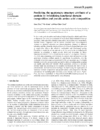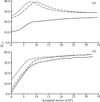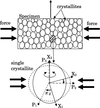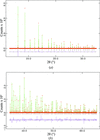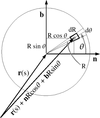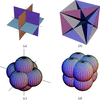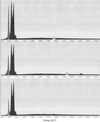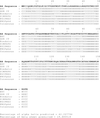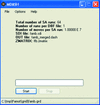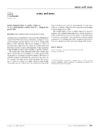issue contents
April 2009 issue

Cover illustration: Three-dimensional reconstructed crystal (purple), loop (yellow) and solvent (transparent pink) for a native DNA sample. Courtesy of Brockhauser, Di Michiel, McGeehan, McCarthy & Ravelli [J. Appl. Cryst. (2008), 41, 1057-1066].
research papers
An isothermal phase map for the Ba–Sr–Co–Fe–O system is proposed.
The miscibility of octene-mLLDPE(D)/LDPE(H) blends was studied with small-angle neutron and X-ray scattering techniques. It was found that the blends are miscible in both the melt and the quenched states, and two polymer components are cocrystallized via fast crystallization from the melt state.
A user friendly web server, called PQSA-Pred, has been established at https://218.65.61.89:8080/bioinfo/pqsa-pred, by which one can predict the quaternary structural attributes of proteins according to their sequence information alone.
An initial report is presented of a high-throughput X-ray diffraction method, combining simultaneous data collection of multiple diffraction patterns with the electronic partitioning required to calculate lattice parameter information for the individual samples.
The implementation and demonstration of a soft chemical constraint, based on bond valence calculations, for the reverse Monte Carlo program RMCProfile is reported.
The stress–strain relation used in X-ray stress analysis for polycrystalline specimens with fibre texture is re-examined by taking into account the symmetry of the reciprocal lattice (Laue class) of the constituent crystallites. The treatment is applicable to any polycrystalline specimen in any Laue class.
This work presents angle calculations necessary for orienting line-shaped beam spots and for calculating effective azimuth and tilt angles for residual stress determination in a four-circle goniometer.
Thermal treatment of gel precursors with initial compositions VxZr1−xO2 (0 ≤ x ≤ 0.1), with a final annealing temperature of 723 or 1573 K, resulted in a major tetragonal or pure monoclinic zirconia phase. Each pure or vanadium-doped zirconia specimen is characterized by a prevalent crystallite shape, a volume-weighted crystallite size distribution and a second-order crystalline lattice strain distribution.
The intensity distributions from an orthorhombic single crystal containing twin boundaries (110), 〈1 0〉 that tend to short-range order were simulated in the reciprocal lattice space using Monte Carlo techniques.
0〉 that tend to short-range order were simulated in the reciprocal lattice space using Monte Carlo techniques.
The design and optimization of focusing neutron guide elements using swarm intelligence are described. A large gain in performance is observed compared with the best human designs for complex devices.
The ikaite–vaterite transformation was observed in polycrystalline samples during dehydration. Although the original ikaite morphology is retained following dehydration, development of domain structure is observed in individual crystallites. A structural model is developed to describe the transformation to vaterite.
A novel method for extracting the crystal symmetry and unit-cell parameters from electron backscatter diffraction patterns is described.
Open  access
access
 access
accessAnomalous extra spots visible in electron diffraction patterns of silicon nanowires and silicon thin films are explained by the presence of micro- and nanotwins.
The very small negative thermal expansion of ReO3 below room temperature has been confirmed from careful high-resolution powder diffraction measurements. The systematic errors that can arise when using synchrotron radiation for such studies are considered.
Molecular envelopes determined from SAXS/WAXS solution scattering can be used to locate the heavy-atom sites in the crystallographic unit cell.
It is demonstrated that high-intensity illumination with an Ar-ion laser beam can generate domain-inversion patterning in KNbO3 crystals.
A numerical method for the evaluation of the Fourier transform of a general space curve is described and its application to low-resolution crystallographic data analysis is presented.
Agarose gel stabilizes the AspRS enzyme crystal lattice for soaking with a catalytic intermediate analog. By contrast, AspRS crystals prepared in solution broke apart within 10–30 s after the ligand was introduced into the mother liquor, and subsequently these fragments became an amorphous precipitate.
Download citation


Download citation


The novel laser matrix Lu2SiO5 (LSO) presents a structure consisting of two interpenetrating frameworks, Lu1O6 and Lu2O7. The material shows a maximum thermal expansion of 10.1105 × 10−6 K and thermal conductivity of 3.67 W m−1 K−1 at 303.15 K, while exhibiting relatively large anisotropic thermal properties.
For application in time-resolved wide-angle X-ray diffraction studies, a method for the automatic mapping of fiber diffraction patterns into reciprocal space has been designed.
Phasing of small and medium-sized molecules is attempted at different data resolutions via different algorithms.
Conditions for a planar homophase grain boundary to be concurrently a tilt and a twist boundary are given.
Methodologies to separate different signals in anomalous grazing incidence small-angle X-ray scattering are presented for well characterized samples: two binary nanocomposite films with Au or Cu nanoclusters encapsulated in amorphous carbon and one ternary film including both Au and Cu nanoclusters within the carbon matrix. The differential method appears the most efficient since the anomalous signal is well separated from that of the non-anomalous contributions, whatever their scattering profiles.
short communications
A comparison between the resonant scattering curve obtained by anomalous small-angle X-ray scattering at the X-ray absorption edge of Ni and the small-angle neutron scattering curve from an Al89Ni6La5 alloy sample is reported. It is shown that the two curves are proportional to each other and to the Ni–Ni partial structure factor.
Chord length density functions and characteristic details of the small-angle scattering of infinitely long cylinders with pentagonal/hexagonal right section are analyzed.
A method is described for using X-ray fluorescence for determining the solution phase reaction stoichiometry of heavy atom incorporation reactions.
This paper describes the implementation of an online tool for the collection and qualitative analysis of X-ray fluorescence spectra that allows the identification of ions in a crystal or a solution of a biological macromolecule.
computer programs
A web-based computing server for consensus prediction of secondary structure was developed. It is available on the World Wide Web at https://bioserver1.physics.iisc.ernet.in/cssp/.
The program OLEX2 provides tools for the determination, visualization and analysis of molecular crystal structures.
Open  access
access
 access
accessDAMMIF, an enhanced and significantly faster implementation of the ab-initio shape-determination program DAMMIN for small-angle scattering data, is presented.
Irena, a tool suite of scientific software for analysis of small-angle scattering data, is presented. Models, the graphical user interface and user support tools included in the package as well as software distribution are described.
Instrumental drift correction by nonparametric statistics is described.
A program that exploits a commodity grid to accelerate crystal structure solution from powder diffraction data, using the DASH program, is described.
A program that exploits the increasing availability of computers with more than one CPU or with CPUs with multiple cores to accelerate structure solution from powder diffraction data, using the DASH program, is described.
letters to the editor
Open  access
access
 access
accessThe restraint-based procedure in least-squares refinement is critiqued and the advantages of using internal coordinates are discussed.
notes and news
Free 



 journal menu
journal menu











